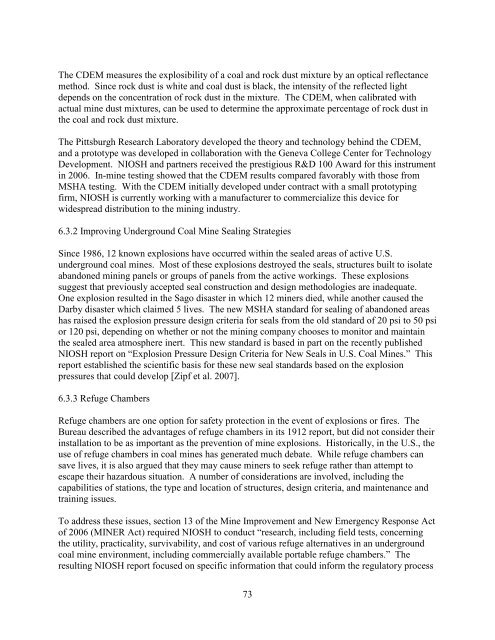One Hundred Years of Federal Mining Safety and Health Research
One Hundred Years of Federal Mining Safety and Health Research
One Hundred Years of Federal Mining Safety and Health Research
- No tags were found...
Create successful ePaper yourself
Turn your PDF publications into a flip-book with our unique Google optimized e-Paper software.
The CDEM measures the explosibility <strong>of</strong> a coal <strong>and</strong> rock dust mixture by an optical reflectance<br />
method. Since rock dust is white <strong>and</strong> coal dust is black, the intensity <strong>of</strong> the reflected light<br />
depends on the concentration <strong>of</strong> rock dust in the mixture. The CDEM, when calibrated with<br />
actual mine dust mixtures, can be used to determine the approximate percentage <strong>of</strong> rock dust in<br />
the coal <strong>and</strong> rock dust mixture.<br />
The Pittsburgh <strong>Research</strong> Laboratory developed the theory <strong>and</strong> technology behind the CDEM,<br />
<strong>and</strong> a prototype was developed in collaboration with the Geneva College Center for Technology<br />
Development. NIOSH <strong>and</strong> partners received the prestigious R&D 100 Award for this instrument<br />
in 2006. In-mine testing showed that the CDEM results compared favorably with those from<br />
MSHA testing. With the CDEM initially developed under contract with a small prototyping<br />
firm, NIOSH is currently working with a manufacturer to commercialize this device for<br />
widespread distribution to the mining industry.<br />
6.3.2 Improving Underground Coal Mine Sealing Strategies<br />
Since 1986, 12 known explosions have occurred within the sealed areas <strong>of</strong> active U.S.<br />
underground coal mines. Most <strong>of</strong> these explosions destroyed the seals, structures built to isolate<br />
ab<strong>and</strong>oned mining panels or groups <strong>of</strong> panels from the active workings. These explosions<br />
suggest that previously accepted seal construction <strong>and</strong> design methodologies are inadequate.<br />
<strong>One</strong> explosion resulted in the Sago disaster in which 12 miners died, while another caused the<br />
Darby disaster which claimed 5 lives. The new MSHA st<strong>and</strong>ard for sealing <strong>of</strong> ab<strong>and</strong>oned areas<br />
has raised the explosion pressure design criteria for seals from the old st<strong>and</strong>ard <strong>of</strong> 20 psi to 50 psi<br />
or 120 psi, depending on whether or not the mining company chooses to monitor <strong>and</strong> maintain<br />
the sealed area atmosphere inert. This new st<strong>and</strong>ard is based in part on the recently published<br />
NIOSH report on “Explosion Pressure Design Criteria for New Seals in U.S. Coal Mines.” This<br />
report established the scientific basis for these new seal st<strong>and</strong>ards based on the explosion<br />
pressures that could develop [Zipf et al. 2007].<br />
6.3.3 Refuge Chambers<br />
Refuge chambers are one option for safety protection in the event <strong>of</strong> explosions or fires. The<br />
Bureau described the advantages <strong>of</strong> refuge chambers in its 1912 report, but did not consider their<br />
installation to be as important as the prevention <strong>of</strong> mine explosions. Historically, in the U.S., the<br />
use <strong>of</strong> refuge chambers in coal mines has generated much debate. While refuge chambers can<br />
save lives, it is also argued that they may cause miners to seek refuge rather than attempt to<br />
escape their hazardous situation. A number <strong>of</strong> considerations are involved, including the<br />
capabilities <strong>of</strong> stations, the type <strong>and</strong> location <strong>of</strong> structures, design criteria, <strong>and</strong> maintenance <strong>and</strong><br />
training issues.<br />
To address these issues, section 13 <strong>of</strong> the Mine Improvement <strong>and</strong> New Emergency Response Act<br />
<strong>of</strong> 2006 (MINER Act) required NIOSH to conduct “research, including field tests, concerning<br />
the utility, practicality, survivability, <strong>and</strong> cost <strong>of</strong> various refuge alternatives in an underground<br />
coal mine environment, including commercially available portable refuge chambers.” The<br />
resulting NIOSH report focused on specific information that could inform the regulatory process<br />
73
















